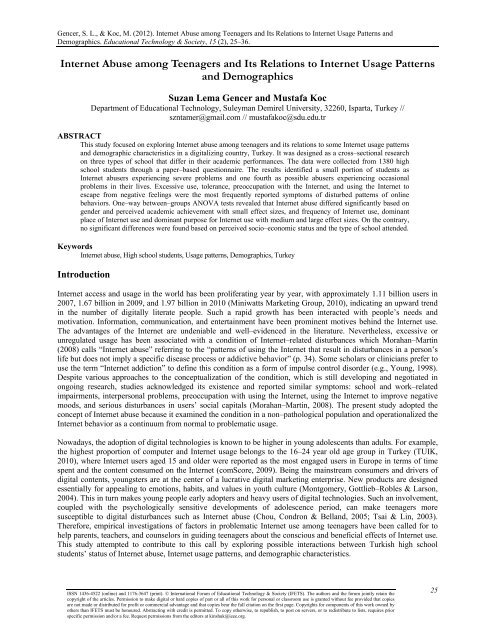April 2012 Volume 15 Number 2 - Educational Technology & Society
April 2012 Volume 15 Number 2 - Educational Technology & Society
April 2012 Volume 15 Number 2 - Educational Technology & Society
Create successful ePaper yourself
Turn your PDF publications into a flip-book with our unique Google optimized e-Paper software.
Gencer, S. L., & Koc, M. (<strong>2012</strong>). Internet Abuse among Teenagers and Its Relations to Internet Usage Patterns and<br />
Demographics. <strong>Educational</strong> <strong>Technology</strong> & <strong>Society</strong>, <strong>15</strong> (2), 25–36.<br />
Internet Abuse among Teenagers and Its Relations to Internet Usage Patterns<br />
and Demographics<br />
Suzan Lema Gencer and Mustafa Koc<br />
Department of <strong>Educational</strong> <strong>Technology</strong>, Suleyman Demirel University, 32260, Isparta, Turkey //<br />
szntamer@gmail.com // mustafakoc@sdu.edu.tr<br />
ABSTRACT<br />
This study focused on exploring Internet abuse among teenagers and its relations to some Internet usage patterns<br />
and demographic characteristics in a digitalizing country, Turkey. It was designed as a cross–sectional research<br />
on three types of school that differ in their academic performances. The data were collected from 1380 high<br />
school students through a paper–based questionnaire. The results identified a small portion of students as<br />
Internet abusers experiencing severe problems and one fourth as possible abusers experiencing occasional<br />
problems in their lives. Excessive use, tolerance, preoccupation with the Internet, and using the Internet to<br />
escape from negative feelings were the most frequently reported symptoms of disturbed patterns of online<br />
behaviors. One–way between–groups ANOVA tests revealed that Internet abuse differed significantly based on<br />
gender and perceived academic achievement with small effect sizes, and frequency of Internet use, dominant<br />
place of Internet use and dominant purpose for Internet use with medium and large effect sizes. On the contrary,<br />
no significant differences were found based on perceived socio–economic status and the type of school attended.<br />
Keywords<br />
Internet abuse, High school students, Usage patterns, Demographics, Turkey<br />
Introduction<br />
Internet access and usage in the world has been proliferating year by year, with approximately 1.11 billion users in<br />
2007, 1.67 billion in 2009, and 1.97 billion in 2010 (Miniwatts Marketing Group, 2010), indicating an upward trend<br />
in the number of digitally literate people. Such a rapid growth has been interacted with people’s needs and<br />
motivation. Information, communication, and entertainment have been prominent motives behind the Internet use.<br />
The advantages of the Internet are undeniable and well–evidenced in the literature. Nevertheless, excessive or<br />
unregulated usage has been associated with a condition of Internet–related disturbances which Morahan–Martin<br />
(2008) calls “Internet abuse” referring to the “patterns of using the Internet that result in disturbances in a person’s<br />
life but does not imply a specific disease process or addictive behavior” (p. 34). Some scholars or clinicians prefer to<br />
use the term “Internet addiction” to define this condition as a form of impulse control disorder (e.g., Young, 1998).<br />
Despite various approaches to the conceptualization of the condition, which is still developing and negotiated in<br />
ongoing research, studies acknowledged its existence and reported similar symptoms: school and work–related<br />
impairments, interpersonal problems, preoccupation with using the Internet, using the Internet to improve negative<br />
moods, and serious disturbances in users’ social capitals (Morahan–Martin, 2008). The present study adopted the<br />
concept of Internet abuse because it examined the condition in a non–pathological population and operationalized the<br />
Internet behavior as a continuum from normal to problematic usage.<br />
Nowadays, the adoption of digital technologies is known to be higher in young adolescents than adults. For example,<br />
the highest proportion of computer and Internet usage belongs to the 16–24 year old age group in Turkey (TUIK,<br />
2010), where Internet users aged <strong>15</strong> and older were reported as the most engaged users in Europe in terms of time<br />
spent and the content consumed on the Internet (comScore, 2009). Being the mainstream consumers and drivers of<br />
digital contents, youngsters are at the center of a lucrative digital marketing enterprise. New products are designed<br />
essentially for appealing to emotions, habits, and values in youth culture (Montgomery, Gottlieb–Robles & Larson,<br />
2004). This in turn makes young people early adopters and heavy users of digital technologies. Such an involvement,<br />
coupled with the psychologically sensitive developments of adolescence period, can make teenagers more<br />
susceptible to digital disturbances such as Internet abuse (Chou, Condron & Belland, 2005; Tsai & Lin, 2003).<br />
Therefore, empirical investigations of factors in problematic Internet use among teenagers have been called for to<br />
help parents, teachers, and counselors in guiding teenagers about the conscious and beneficial effects of Internet use.<br />
This study attempted to contribute to this call by exploring possible interactions between Turkish high school<br />
students’ status of Internet abuse, Internet usage patterns, and demographic characteristics.<br />
ISSN 1436-4522 (online) and 1176-3647 (print). © International Forum of <strong>Educational</strong> <strong>Technology</strong> & <strong>Society</strong> (IFETS). The authors and the forum jointly retain the<br />
copyright of the articles. Permission to make digital or hard copies of part or all of this work for personal or classroom use is granted without fee provided that copies<br />
are not made or distributed for profit or commercial advantage and that copies bear the full citation on the first page. Copyrights for components of this work owned by<br />
others than IFETS must be honoured. Abstracting with credit is permitted. To copy otherwise, to republish, to post on servers, or to redistribute to lists, requires prior<br />
specific permission and/or a fee. Request permissions from the editors at kinshuk@ieee.org.<br />
25

















